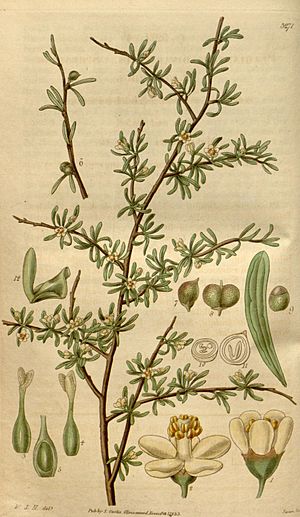Plagianthus facts for kids
Quick facts for kids Plagianthus |
|
|---|---|
 |
|
| Plagianthus divaricatus, illustration with analysis by William Jackson Hooker | |
| Scientific classification |
|
| Kingdom: | Plantae |
| Clade: | Tracheophytes |
| Clade: | Angiosperms |
| Clade: | Eudicots |
| Clade: | Rosids |
| Order: | Malvales |
| Family: | Malvaceae |
| Subfamily: | Malvoideae |
| Tribe: | Malveae |
| Genus: | Plagianthus J.R.Forst. & G.Forst. |
| Type species | |
| Plagianthus divaricatus J.R.Forst. & G.Forst.
|
|
| Species | |
|
|
| Synonyms | |
|
|
Plagianthus is a group of flowering plants. You can only find them in New Zealand and the Chatham Islands. For a long time, scientists weren't sure which plant family Plagianthus belonged to. But now, special studies of their genes show they are part of the Malvaceae family. This family includes plants like mallows and hibiscus. The name Plagianthus means "slanted flowers."
Contents
About Plagianthus Plants
There are two main types, or species, of Plagianthus plants.
Plagianthus divaricatus
One species is called P. divaricatus. This plant is a shrub that spreads out its branches. It grows in wet, salty areas, like the edges of salt marshes.
Plagianthus regius
The other species is P. regius. This plant grows into a tree. When it's young, it might also have spreading branches, like a shrub. This is true for the regius type. But another type, called chathamica, does not spread out its branches when it's young.
Related Plants
Today, scientists only recognize these two species of Plagianthus. In the past, some plants from other groups were thought to be part of Plagianthus. These included plants like Hoheria from New Zealand and Asterotrichion, Lawrencia, and Gynatrix from Australia. Now, all these related groups are put together in a larger informal group. It is called the "Plagianthus alliance."
See Also
 In Spanish: Plagianthus para niños
In Spanish: Plagianthus para niños

